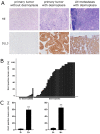DLL3 (delta-like protein 3) expression correlates with stromal desmoplasia and lymph node metastases in medullary thyroid carcinomas
- PMID: 33617464
- PMCID: PMC8052580
- DOI: 10.1530/EC-20-0611
DLL3 (delta-like protein 3) expression correlates with stromal desmoplasia and lymph node metastases in medullary thyroid carcinomas
Abstract
Medullary thyroid carcinomas (MTC) are rare and aggressive neuroendocrine tumors of the thyroid. About 70% of MTC are sporadic; approximately 50% of those harbor somatic RET mutation. DLL3 is widely expressed in many neuroendocrine tumors and has been evaluated as a potential therapeutic target. Since stromal desmoplasia in sporadic MTC has been identified as a reliable predictor of aggressive behavior and development of lymph node metastases, a possible correlation of DLL3 expression with the presence of stromal desmoplasia was of particular interest. 59 paraffin-embedded samples of sporadic MTC with (44 cases) and without (15 cases) stromal desmoplasia and known lymph node status were included. DLL3 expression was determined by immunohistochemistry; no expression (0%), low expression (1-49%) and high expression (≥50%) were correlated with clinicopathological data. The proportion of DLL3 positivity was significantly correlated with both stromal desmoplasia (P < 0.0001) and lymph node metastases (P < 0.0001). MTC without stromal desmoplasia consistently lack DLL3 expression. This is the first study to focus on MTC regarding DLL3 expression and the relationship to various factors. Our results demonstrate that expression of DLL3 in MTC represents a reliable surrogate marker for stromal desmoplasia and lymph node metastases and might be an indicator for aggressive clinical behavior. DLL3 expression in ≥50% of tumor cells virtually excludes MTC without stromal desmoplasia. DLL3 was discussed as a potential therapeutic target in malignant tumors of other locations with positive immunohistochemical reaction and might therefore be a new therapeutic option in MTC, as well.
Keywords: DLL3; medullary thyroid carcinoma; notch pathway; stromal desmoplasia; thyroid cancer.
Figures


Similar articles
-
The mismatch repair system is not affected in medullary thyroid carcinoma independent of stromal desmoplasia or ret proto-oncogene mutation.Ann Diagn Pathol. 2020 Feb;44:151445. doi: 10.1016/j.anndiagpath.2019.151445. Epub 2019 Dec 14. Ann Diagn Pathol. 2020. PMID: 31862521
-
Expression of somatostatin receptor 2A in medullary thyroid carcinoma is associated with lymph node metastasis.APMIS. 2016 Oct;124(10):839-45. doi: 10.1111/apm.12584. Epub 2016 Aug 19. APMIS. 2016. PMID: 27539746
-
Reduced Retinoblastoma Protein Expression Is Associated with Decreased Patient Survival in Medullary Thyroid Cancer.Thyroid. 2017 Dec;27(12):1523-1533. doi: 10.1089/thy.2017.0113. Thyroid. 2017. PMID: 29105562 Free PMC article.
-
Measuring discrepancies between simple medullary and synchronous medullary/papillary thyroid carcinomas: a comparative cross-sectional study.Front Endocrinol (Lausanne). 2024 Jan 22;14:1301200. doi: 10.3389/fendo.2023.1301200. eCollection 2023. Front Endocrinol (Lausanne). 2024. PMID: 38317715 Free PMC article. Review.
-
Translating the desmoplastic microenvironment of medullary thyroid cancer into surgical practice.Endocrine. 2025 Feb;87(2):430-435. doi: 10.1007/s12020-024-04060-3. Epub 2024 Sep 30. Endocrine. 2025. PMID: 39349720 Review.
Cited by
-
Transcriptomic Differences in Medullary Thyroid Carcinoma According to Grade.Endocr Pathol. 2024 Sep;35(3):207-218. doi: 10.1007/s12022-024-09817-0. Epub 2024 Jul 3. Endocr Pathol. 2024. PMID: 38958823 Free PMC article.
-
Exploring the expression of DLL3 in gastroenteropancreatic neuroendocrine neoplasms and its potential diagnostic value.Sci Rep. 2025 Jan 26;15(1):3287. doi: 10.1038/s41598-025-86237-y. Sci Rep. 2025. PMID: 39865119 Free PMC article.
-
Sporadic Medullary Thyroid Carcinoma: Towards a Precision Medicine.Front Endocrinol (Lausanne). 2022 Mar 29;13:864253. doi: 10.3389/fendo.2022.864253. eCollection 2022. Front Endocrinol (Lausanne). 2022. PMID: 35422765 Free PMC article. Review.
-
CAR-T therapy for endocrine neoplasms: novel targets and combination of therapies.Front Endocrinol (Lausanne). 2025 Feb 11;16:1517525. doi: 10.3389/fendo.2025.1517525. eCollection 2025. Front Endocrinol (Lausanne). 2025. PMID: 40007813 Free PMC article. Review.
-
Targeting DLL3: Innovative Strategies for Tumor Treatment.Pharmaceutics. 2025 Apr 16;17(4):520. doi: 10.3390/pharmaceutics17040520. Pharmaceutics. 2025. PMID: 40284515 Free PMC article. Review.
References
-
- LiVolsi VDR, Komminoth P, Mete O, Mulligan L, Schmid KW, Waguespack SG, Elisei R, Eng C.Multiple endocrine neoplasia type 2. In WHO Classification of Tumors of Endocrine Organs, pp. 248–252. Eds RLloyd RO, Klöppel G, Rosai J.Lyon: International Agency for Research on Cancer (International Arctic Research Center), 2017.
LinkOut - more resources
Full Text Sources
Other Literature Sources

